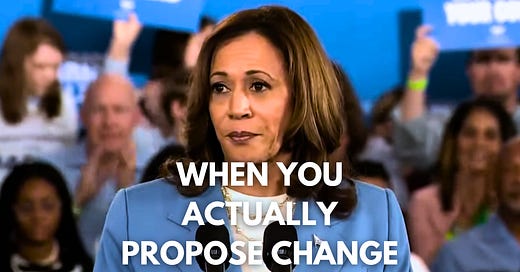When You Actually Propose Change
Kamala Harris rolled out some common-sense, liberal economic plans. Our media's reaction tells you everything you need to know about the state of things
This is a subscribers-only article. To gain access to it and other exclusive materials, subscribe to Dispatches From A Collapsing State. This independent venture, which supplies analysis you won’t find anywhere else, depends on your support. And, if you haven’t already, check out the article from earlier this week detailing the MAGA civil war between open Neo-Nazis and the Tech Fascists who have already taken over the Trump Campaign.
This week, Vice President and Democratic nominee Kamala Harris laid out the beginnings of her economic agenda. For many of us, including myself, who are both advocating for fundamental and necessary changes and who are working in the trenches to create that change, it was highly anticipated.
I want to pull the curtain back just a bit. In all of the reactions and what passes for “analysis,” the picture painted for the population is misleading. The accelerated nature of Harris’s candidacy - moving from running mate to presumptive nominee completely out of nowhere and with only a sprint to the election remaining - meant that this would not be an ordinary situation. She was handed President Joe Biden’s campaign, including staff, consultants, strategists, and policy proposals. Over time, she has been able to make key adjustments and add some of her own team to the mix, but what was necessary was a “build it as you go” approach that meant an agenda was going to be constructed on the fly.
For those of us in the business of creating policy proposals and advocating change, this amounted to the most exciting game of 52 Pickup imaginable. The generational shift within the Democratic Party presented a novel challenge: the domination of the party by the old guard - Biden, Nancy Pelosi, Chuck Schumer, and an assortment of strategists, lobbyists, and think-tank/institutions - was starting to slip, leading to an opportunity to begin having conversations that had been effectively stalled for decades.
What Harris presented was not an ironclad agenda. These are inklings of what could be possible, or, rather, signals of where her priorities lie. We do not know yet what a Harris Presidency would look like or feel like. We have suggestions and gestures. And, as I detailed in my article from The Stakes special series, this is an invitation for grassroots voices to form coalitions and engage in dialogue and pressure Harris and her presumptive administration.




